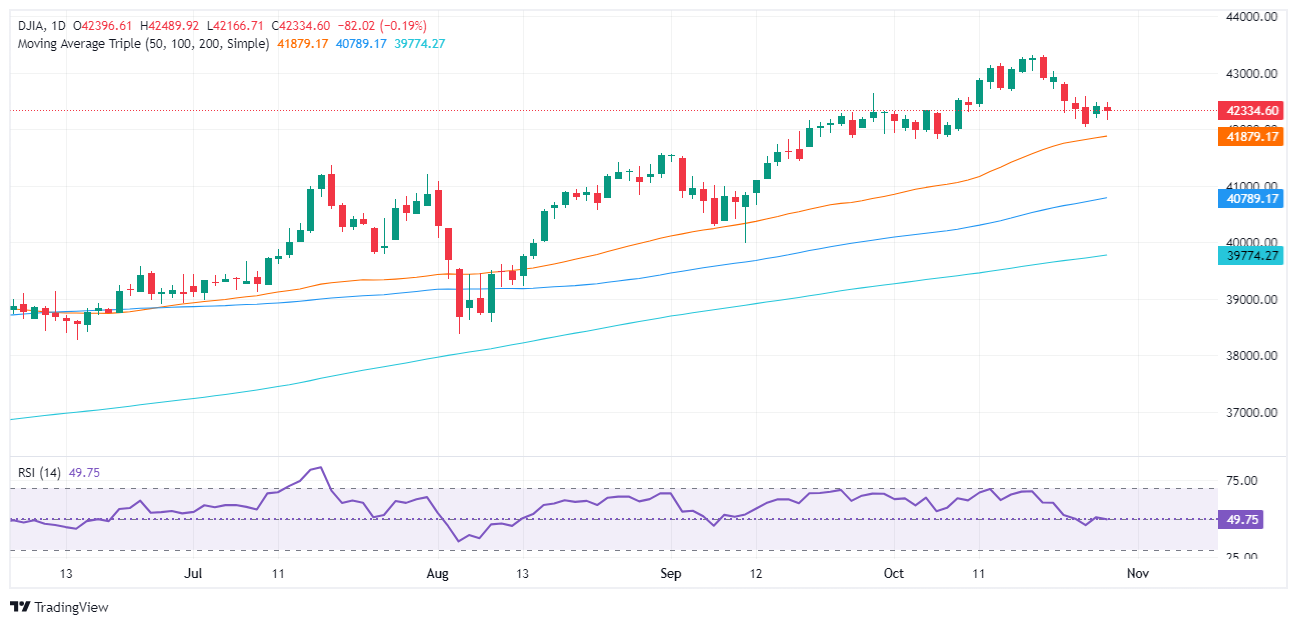- Dow Jones dips from 42,500 as US Treasury yields rise.
- US job openings drop to lowest level since January 2021, supporting rate cut bets.
- Consumer Confidence jumps to 108.7, the highest since March 2021.
- Boeing leads Dow gains, up 2.93% after share sale, while Chevron, Coca-Cola and Home Depot post notable losses.
The Dow Jones Industrial Average (DJIA) trims off Monday’s gains, retreating from daily highs near 42,500 and down over 0.25%. US Treasury bond yields cling to gains. US jobs market data augmented the odds that the Federal Reserve (Fed) will cut interest rates at the November meeting, while Consumer Confidence improved sharply.
US bond yields continued to rise as the 10-year Treasury note yield rose three-and-a-half basis points to 4.32% after the US Department of Labor revealed that job openings in the US tumbled to their lowest level in three-and-a-half years.
US job vacancies slumped to 7.44 million in September from 7.86 million a month before, the fewest job openings since January 2021. At the same time, the Conference Board showed that Americans grew the most optimistic about the economy as the index increased from 99.2 to 108.7, its most strongly gain since March 2021.
Following the data, the CME FedWatch Tool shows odds for a 25-basis-point (bps) rate cut by the Fed jumping to 98%, up from 96% a day ago. This would leave rates in the 4.50%-4.75% range.
Dow Jones news
The earnings season continued on Tuesday. Among the leading companies that compose the Dow Jones Industrial Average, McDonald’s (MCD) reported earnings per share (EPS) of $3.23, above estimates of $3.20. Revenue was also above forecasts of $6.82 billion at $6.87 billion. Despite this, MCD clings to minuscule gains of 0.03% at $296.88 per share.
In the meantime, Boeing (BA) raised over $21 billion via its share sale on Monday, selling 112.5 million shares at $143.00 each as the company prepares to repair its balance sheet.
Following the share sale, Boeing was the foremost leader in the session, gaining 2.93% at $155.10 per share, followed by Salesforce (CRM), up 1.31% at $297.61 a share, and Cisco Systems (CSCO), up 0.94% at $55.80. The laggard of the session was Chevron (CXP), losing 1.14% to $148.82; Coca-Cola (KO), down by 1.27% to $65.82 a share; and Home Depot (HD) edged 1.80% lower to $395.65.
Dow Jones price forecast
The Dow Jones consolidated just below the 42,350 area for the second straight day after forming an “inside day,” which could have opened the door for further upside. However, the DJIA slipped below Monday’s close, paving the way for further downside.
If sellers move in and push the DJIA below the October 25 swing low of 42,043, look for a test of the 42,000 mark. Up next lies the 50-day Simple Moving Average (SMA) at 41,879.
For a bullish continuation, the DJIA must clear the October 25 peak at 42,596. Once surpassed, the next resistance would be 43,000, followed by a record high at 43,322.
Momentum remains bullish as depicted by the Relative Strength Index (RSI), which pierced above its neutral line. This hints that buyers bought the dip and are eyeing higher levels.
Dow Jones daily chart
Dow Jones FAQs
The Dow Jones Industrial Average, one of the oldest stock market indices in the world, is compiled of the 30 most traded stocks in the US. The index is price-weighted rather than weighted by capitalization. It is calculated by summing the prices of the constituent stocks and dividing them by a factor, currently 0.152. The index was founded by Charles Dow, who also founded the Wall Street Journal. In later years it has been criticized for not being broadly representative enough because it only tracks 30 conglomerates, unlike broader indices such as the S&P 500.
Many different factors drive the Dow Jones Industrial Average (DJIA). The aggregate performance of the component companies revealed in quarterly company earnings reports is the main one. US and global macroeconomic data also contributes as it impacts on investor sentiment. The level of interest rates, set by the Federal Reserve (Fed), also influences the DJIA as it affects the cost of credit, on which many corporations are heavily reliant. Therefore, inflation can be a major driver as well as other metrics which impact the Fed decisions.
Dow Theory is a method for identifying the primary trend of the stock market developed by Charles Dow. A key step is to compare the direction of the Dow Jones Industrial Average (DJIA) and the Dow Jones Transportation Average (DJTA) and only follow trends where both are moving in the same direction. Volume is a confirmatory criteria. The theory uses elements of peak and trough analysis. Dow’s theory posits three trend phases: accumulation, when smart money starts buying or selling; public participation, when the wider public joins in; and distribution, when the smart money exits.
There are a number of ways to trade the DJIA. One is to use ETFs which allow investors to trade the DJIA as a single security, rather than having to buy shares in all 30 constituent companies. A leading example is the SPDR Dow Jones Industrial Average ETF (DIA). DJIA futures contracts enable traders to speculate on the future value of the index and Options provide the right, but not the obligation, to buy or sell the index at a predetermined price in the future. Mutual funds enable investors to buy a share of a diversified portfolio of DJIA stocks thus providing exposure to the overall index.
Information on these pages contains forward-looking statements that involve risks and uncertainties. Markets and instruments profiled on this page are for informational purposes only and should not in any way come across as a recommendation to buy or sell in these assets. You should do your own thorough research before making any investment decisions. FXStreet does not in any way guarantee that this information is free from mistakes, errors, or material misstatements. It also does not guarantee that this information is of a timely nature. Investing in Open Markets involves a great deal of risk, including the loss of all or a portion of your investment, as well as emotional distress. All risks, losses and costs associated with investing, including total loss of principal, are your responsibility. The views and opinions expressed in this article are those of the authors and do not necessarily reflect the official policy or position of FXStreet nor its advertisers. The author will not be held responsible for information that is found at the end of links posted on this page.
If not otherwise explicitly mentioned in the body of the article, at the time of writing, the author has no position in any stock mentioned in this article and no business relationship with any company mentioned. The author has not received compensation for writing this article, other than from FXStreet.
FXStreet and the author do not provide personalized recommendations. The author makes no representations as to the accuracy, completeness, or suitability of this information. FXStreet and the author will not be liable for any errors, omissions or any losses, injuries or damages arising from this information and its display or use. Errors and omissions excepted.
The author and FXStreet are not registered investment advisors and nothing in this article is intended to be investment advice.
Recommended content
Editors’ Picks

EUR/USD recovers from two-year lows, stays below 1.0450
EUR/USD recovers modestly and trades above 1.0400 after setting a two-year low below 1.0350 following the disappointing PMI data from Germany and the Eurozone on Friday. Market focus shifts to November PMI data releases from the US.

GBP/USD falls to six-month lows below 1.2550, eyes on US PMI
GBP/USD extends its losses for the third successive session and trades at a fresh fix-month low below 1.2550 on Friday. Disappointing PMI data from the UK weigh on Pound Sterling as investors await US PMI data releases.

Gold price refreshes two-week high, looks to build on momentum beyond $2,700 mark
Gold price hits a fresh two-week top during the first half of the European session on Friday, with bulls now looking to build on the momentum further beyond the $2,700 mark. This marks the fifth successive day of a positive move and is fueled by the global flight to safety amid persistent geopolitical tensions stemming from the intensifying Russia-Ukraine war.

S&P Global PMIs set to signal US economy continued to expand in November
The S&P Global preliminary PMIs for November are likely to show little variation from the October final readings. Markets are undecided on whether the Federal Reserve will lower the policy rate again in December.

Eurozone PMI sounds the alarm about growth once more
The composite PMI dropped from 50 to 48.1, once more stressing growth concerns for the eurozone. Hard data has actually come in better than expected recently – so ahead of the December meeting, the ECB has to figure out whether this is the PMI crying wolf or whether it should take this signal seriously. We think it’s the latter.

Best Forex Brokers with Low Spreads
VERIFIED Low spreads are crucial for reducing trading costs. Explore top Forex brokers offering competitive spreads and high leverage. Compare options for EUR/USD, GBP/USD, USD/JPY, and Gold.
